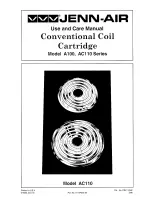
2
Important Cord Information
This appliance has a polarized plug (one blade is wider than the other). To reduce the risk of electric shock, this plug is intended to fit
into a polarized outlet only one way. If the plug does not fit fully into the outlet, reverse the plug. If it still does not fit, contact a qualified
electrician. Do not attempt to modify the plug in any way. Connect the power supply cord to a 120VAC electrical outlet only.
A short, detachable power supply cord is provided to reduce the risk of becoming entangled in or tripping over a longer cord. Extension
cords may be used if care is properly exercised in their use. If an extension cord is used, the marked electrical rating of the extension
cord should be at least as great as the electrical rating of the appliance. The extension cord should be arranged so that it will not drape
over the countertop or tabletop where it can be pulled on by children or tripped over unintentionally.
How to Assemble
1. Place the skillet upside down on a table or counter.
2. Remove the four screws from the mounting projections on the skillet body and set aside.
3. Position the leg handle assemblies on the skillet, lining up the holes in the legs with the mounting projections on the skillet.
4. Replace the screws and fasten securely (Fig. A). When properly assembled, the skillet should sit level.
NOTICE:
Continuing to tighten, once secure, can result in the stripping of screws or the cracking of handles
or legs.
5. To attach the cover handle to the cover, first remove the two screws from the handle. For easiest alignment,
hold the handle so the screw holes are facing up. Position the inverted cover over the handle and align the
cover holes with the handle holes. Insert the screws through the holes. Using a Phillips screwdriver, fasten
the handle to the cover until it is secure.
NOTICE:
Continuing to tighten, once secure, can result in the stripping of screws or the cracking of handle
or cover.
How to Use
NOTICE:
This skillet is not intended to be used as a warming tray, hot plate, or for heating any cookware nor to melt wax, gels, plastics,
glue, or other materials for making candles or for other hobbyist activities, or in any commercial or business application. Using this appli-
ance for purposes different from those specified in the instruction manual may cause damage to the appliance and will void the warranty.
Before using for the first time, wash the skillet and cover in warm, soapy water, rinse, and dry. Do not immerse the Control Master
®
heat
control in water or let it come in contact with any liquid.
1. Place skillet on a dry, level, heat-resistant surface away from walls, cabinets, and other objects.
NOTICE:
To prevent possible heat damage to your countertop, place a heat-resistant counter protector, such as aluminum foil, under
the skillet. Take care not to place the foil under the legs.
2. Insert the Control Master
®
heat control probe into the skillet so the two electrical pins on the skillet are fully inserted into the heat
control. Connect the cord to a 120VAC electrical wall outlet only.
3. Turn the Control Master
®
heat control to desired temperature (see page 3). Remove the cover and preheat the skillet. The pilot light
goes off when the selected temperature is reached (approximately 5 to 10 minutes).
NOTE:
Occasionally you may hear a pop or clicking sound while the skillet is preheating; this is due to the expansion of the metal
as it heats and is normal. You may also hear this sound while the skillet is cooling.
4. Prepare the food for cooking. Because the skillet features a nonstick surface, food may be prepared with little or no oil.
NOTICE:
Avoid using no-stick cooking sprays as they may cause the cooking surface to become tacky.
5. Place the food in the skillet and cook according to the temperature-timetable. Adjust the heat according to personal preference and
the particular food being cooked.
During cooking, the pilot light will go on and off indicating desired temperature is being maintained. The pouring spout may be
used as a handy spoon rest and spatula holder during cooking.
For best results use heat-resistant nylon, plastic, rubber, or wooden utensils in the skillet. Do not use metal utensils as they may
scratch the nonstick surface and also become hot if left in the skillet during cooking. Do not cut foods on the cooking surface.
CAUTION!
When the cover is placed on the skillet and the contents are boiling, it is normal for some steam to vent from the pour
spout. Do not reach over the pour spout when steam is venting. Contact with steam can cause burns.
6. Turn the heat control to OFF when cooking is completed. Unplug the heat control from the wall outlet, and then from the appliance.
Allow the skillet to cool before cleaning.
Fig. A






















